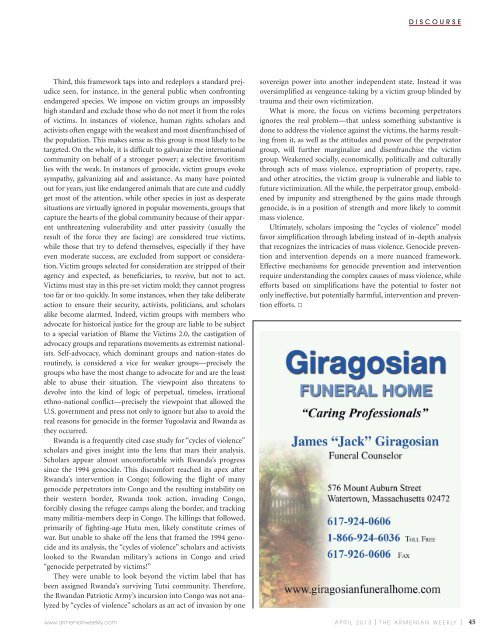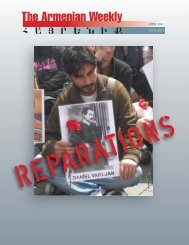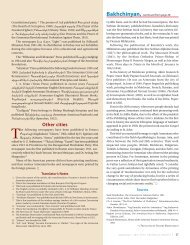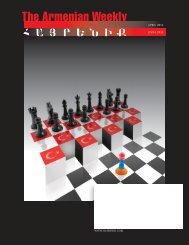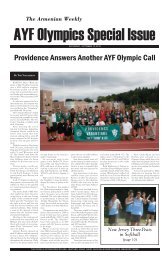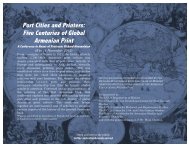Create successful ePaper yourself
Turn your PDF publications into a flip-book with our unique Google optimized e-Paper software.
DISCOURSE<br />
Third, this framework taps into and redeploys a standard prejudice<br />
seen, for instance, in the general public when confronting<br />
endangered species. We impose on victim groups an impossibly<br />
high standard and exclude those who do not meet it from the roles<br />
of victims. In instances of violence, human rights scholars and<br />
activists often engage with the weakest and most disenfranchised of<br />
the population. This makes sense as this group is most likely to be<br />
targeted. On the whole, it is difficult to galvanize the international<br />
community on behalf of a stronger power; a selective favoritism<br />
lies with the weak. In instances of genocide, victim groups evoke<br />
sympathy, galvanizing aid and assistance. As many have pointed<br />
out for years, just like endangered animals that are cute and cuddly<br />
get most of the attention, while other species in just as desperate<br />
situations are virtually ignored in popular movements, groups that<br />
capture the hearts of the global community because of their apparent<br />
unthreatening vulnerability and utter passivity (usually the<br />
result of the force they are facing) are considered true victims,<br />
while those that try to defend themselves, especially if they have<br />
even moderate success, are excluded from support or consideration.<br />
Victim groups selected for consideration are stripped of their<br />
agency and expected, as beneficiaries, to receive, but not to act.<br />
Victims must stay in this pre-set victim mold; they cannot progress<br />
too far or too quickly. In some instances, when they take deliberate<br />
action to ensure their security, activists, politicians, and scholars<br />
alike become alarmed. Indeed, victim groups with members who<br />
advocate for historical justice for the group are liable to be subject<br />
to a special variation of Blame the Victims 2.0, the castigation of<br />
advocacy groups and reparations movements as extremist nationalists.<br />
Self-advocacy, which dominant groups and nation-states do<br />
routinely, is considered a vice for weaker groups—precisely the<br />
groups who have the most change to advocate for and are the least<br />
able to abuse their situation. The viewpoint also threatens to<br />
devolve into the kind of logic of perpetual, timeless, irrational<br />
ethno-national conflict—precisely the viewpoint that allowed the<br />
U.S. government and press not only to ignore but also to avoid the<br />
real reasons for genocide in the former Yugoslavia and Rwanda as<br />
they occurred.<br />
Rwanda is a frequently cited case study for “cycles of violence”<br />
scholars and gives insight into the lens that mars their analysis.<br />
Scholars appear almost uncomfortable with Rwanda’s progress<br />
since the 1994 genocide. This discomfort reached its apex after<br />
Rwanda’s intervention in Congo; following the flight of many<br />
genocide perpetrators into Congo and the resulting instability on<br />
their western border, Rwanda took action, invading Congo,<br />
forcibly closing the refugee camps along the border, and tracking<br />
many militia-members deep in Congo. The killings that followed,<br />
primarily of fighting-age Hutu men, likely constitute crimes of<br />
war. But unable to shake off the lens that framed the 1994 genocide<br />
and its analysis, the “cycles of violence” scholars and activists<br />
looked to the Rwandan military’s actions in Congo and cried<br />
“genocide perpetrated by victims!”<br />
They were unable to look beyond the victim label that has<br />
been assigned Rwanda’s surviving Tutsi community. T<strong>here</strong>fore,<br />
the Rwandan Patriotic Army’s incursion into Congo was not analyzed<br />
by “cycles of violence” scholars as an act of invasion by one<br />
www.armenianweekly.com<br />
sovereign power into another independent state. Instead it was<br />
oversimplified as vengeance-taking by a victim group blinded by<br />
trauma and their own victimization.<br />
What is more, the focus on victims becoming perpetrators<br />
ignores the real problem—that unless something substantive is<br />
done to address the violence against the victims, the harms resulting<br />
from it, as well as the attitudes and power of the perpetrator<br />
group, will further marginalize and disenfranchise the victim<br />
group. Weakened socially, economically, politically and culturally<br />
through acts of mass violence, expropriation of property, rape,<br />
and other atrocities, the victim group is vulnerable and liable to<br />
future victimization. All the while, the perpetrator group, emboldened<br />
by impunity and strengthened by the gains made through<br />
genocide, is in a position of strength and more likely to commit<br />
mass violence.<br />
Ultimately, scholars imposing the “cycles of violence” model<br />
favor simplification through labeling instead of in-depth analysis<br />
that recognizes the intricacies of mass violence. Genocide prevention<br />
and intervention depends on a more nuanced framework.<br />
Effective mechanisms for genocide prevention and intervention<br />
require understanding the complex causes of mass violence, while<br />
efforts based on simplifications have the potential to foster not<br />
only ineffective, but potentially harmful, intervention and prevention<br />
efforts. a<br />
APRIL 2013 | THE ARMENIAN WEEKLY | 45


